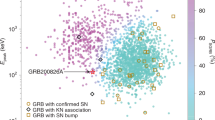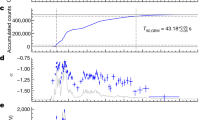Abstract
Long-duration γ-ray bursts (GRBs) are thought to result from the explosions of certain massive stars1, and some are bright enough that they should be observable out to redshifts of z > 20 using current technology2,3,4. Hitherto, the highest redshift measured for any object was z = 6.96, for a Lyman-α emitting galaxy5. Here we report that GRB 090423 lies at a redshift of z ≈ 8.2, implying that massive stars were being produced and dying as GRBs ∼630 Myr after the Big Bang. The burst also pinpoints the location of its host galaxy.
This is a preview of subscription content, access via your institution
Access options
Subscribe to this journal
Receive 51 print issues and online access
$199.00 per year
only $3.90 per issue
Buy this article
- Purchase on Springer Link
- Instant access to full article PDF
Prices may be subject to local taxes which are calculated during checkout



Similar content being viewed by others
References
Woosley, S. E. & Bloom, J. S. The supernova gamma-ray burst connection. Annu. Rev. Astron. Astrophys. 44, 507–556 (2006)
Lamb, D. Q. & Reichart, D. E. Gamma-ray bursts as a probe of the very high redshift universe. Astrophys. J. 536, 1–18 (2000)
Racusin, J. L. et al. Broadband observations of the naked-eye γ -ray burst GRB 080319B. Nature 455, 183–188 (2008)
Bloom, J. S. et al. Observations of the naked-eye GRB080319B: implications of nature’s brightest explosion. Astrophys. J. 691, 723–737 (2009)
Iye, M. et al. A galaxy at a redshift z = 6.96. Nature 443, 186–188 (2006)
Gehrels, N. et al. The Swift Gamma-Ray Burst Mission. Astrophys. J. 611, 1005–1020 (2004)
Jakobsson, P. et al. H I column densities of z > 2 Swift gamma-ray bursts. Astron. Astrophys. 460, L13–L17 (2006)
Chen, H.-W., Prochaska, J. X. & Gnedin, N. Y. A new constraint on the escape fraction in distant galaxies using γ-ray burst afterglow spectroscopy. Astrophys. J. 667, L125–L128 (2007)
Fynbo, J. P. U. et al. Low-resolution spectroscopy of gamma-ray burst optical afterglows: biases in the Swift sample and characterization of the absorbers. Preprint at 〈http://arxiv.org/abs/0907.3449〉 (2009)
Salvaterra, R. et al. GRB 090423 at a redshift of z ≈ 8.1. Nature 10.1038/nature08459 (this issue)
von Kienlin, A. et al. GRB 090423: Fermi GBM observation (correction of isotropic equivalent energy). GCN Circ. 9251, (2009)
Bromm, V. & Loeb, A. High-redshift gamma-ray bursts from population III progenitors. Astrophys. J. 642, 382–388 (2006)
Zhang, B. et al. Physical classification scheme of cosmological gamma-ray bursts and their observational characteristics: on the nature of z = 6.7 GRB 080913 and some short/hard GRBs. Astrophys J. (in the press); preprint at 〈http://arxiv.org/abs/0902.2419v1〉 (2009)
Zhang, B.-B. & Zhang, B. GRB 090423: pseudo burst at z = 1 and its relation to GRB 080913. GCN Circ. 9279, (2009)
Wijers, R. A. M. J. et al. Gamma-ray bursts from stellar remnants - probing the universe at high redshift. Mon. Not. R. Astron. Soc. 294, L13–L17 (1998)
Miralda-Escude, J. Reionization of the intergalactic medium and the damping wing of the Gunn-Peterson Trough. Astrophys. J. 501, 15–22 (1998)
Barkana, R. & Loeb, A. Gamma-ray bursts versus quasars: Lyα signatures of reionization versus cosmological infall. Astrophys. J. 601, 64–77 (2004)
Totani, T. et al. Implications for cosmic reionization from the optical afterglow spectrum of the gamma-ray burst 050904 at z = 6.3. Publ. Astron. Soc. Jpn 58, 485–498 (2009)
Greiner, J. et al. GRB 080913 at redshift 6.7. Astrophys. J. 693, 1610–1620 (2009)
Faucher-Giguere, C.-A., Lidz, A., Hernquist, L. & Zaldarriaga, M. Evolution of the intergalactic opacity: implications for the ionizing background, cosmic star formation, and quasar activity. Astrophys. J. 688, 85–107 (2008)
McQuinn, M. et al. Probing the neutral fraction of the IGM with GRBs during the epoch of reionization. Mon. Not. R. Astron. Soc. 388, 1101–1110 (2008)
Grindlay, J. in Gamma-Ray Burst: Sixth Huntsville Symposium (eds Meegan, C., Kouveliotou, C. & Gehrels, N.) 18–24 (AIP Conf. Ser. 1113, American Institute of Physics, 2009)
Tanvir, N. R. & Jakobsson, P. Observations of GRBs at high redshift. Phil. Trans. R. Soc. A 365, 1377–1384 (2007)
Berger, E. et al. Hubble Space Telescope and Spitzer observations of the afterglow and host galaxy of GRB 050904 at z = 6.295. Astrophys. J. 665, 102–106 (2007)
Komatsu, E. et al. Five-year Wilkinson Microwave Anisotropy Probe observations: cosmological interpretation. Astrophys. J. 180 (suppl.). 330–376 (2009)
Malhotra, S. & Rhoads, J. E. Luminosity functions of Lyα emitters at redshifts z = 6.5 and z = 5.7: evidence against reionization at z≤6.5. Astrophys. J. 617, L5–L8 (2004)
Becker, G. D., Rauch, M. & Sargent, W. L. W. The evolution of optical depth in the Lyα forest: evidence against reionization at z∼6. Astrophys. J. 662, 72–93 (2007)
Willingale, R. et al. Testing the standard fireball model of gamma-ray bursts using late X-ray afterglows measured by Swift. Astrophys. J. 662, 1093–1110 (2007)
Acknowledgements
We thank Ph. Yock, B. Allen, P. Kubanek, M. Jelinek and S. Guziy for their assistance with the BOOTES-3 YA telescope observations (Supplementary Information). This work was partly based on observations obtained at the Gemini Observatory, which is operated by the Association of Universities for Research in Astronomy, Inc., under a cooperative agreement with the US National Science Foundation on behalf of the Gemini partnership: the National Science Foundation (United States), the Science and Technology Facilities Council (United Kingdom), the National Research Council (Canada), CONICYT (Chile), the Australian Research Council (Australia), the Ministério da Ciência e Tecnologia (Brazil) and SECYT (Argentina). This work was also partly based on observations made using ESO telescopes at the La Silla or Paranal observatories by G. Carraro, L. Schmidtobreick, G. Marconi, J. Smoker, V. Ivanov, E. Mason and M. Huertas-Company. The UKIRT is operated by the Joint Astronomy Centre on behalf of the UK Science and Technology Facilities Council. R.J.F. acknowledges a Clay Fellowship.
Author Contributions Triggering observations: N.R.T., D.B.F., A.J.L., E.B., J.S.B., D.P., J. Greiner, A.J.C.-T., A.d.U.P.; analysis of ground-based data: N.R.T., D.B.F., A.J.L., E.B., K.W., J.P.U.F., A.C., J.S.B., J.F., J.D., J. Gorosabel, B.C., D.P., J.R.M., T. Krühler, A.J.C.-T., A.d.U.P., C.G.M.; Swift analysis: P.A.E., R.L.C.S., K.P., R.W., A.J.L., N.R.T., N.G., D.W., P.S., T.S.; observations at various observatories and their automation to accept GRB overrides: A.J.A., A.A., T. Kerr, T.N., A.W.S., K.R., T.W. All authors made contributions through their involvement in the programmes from which the data derive, and contributed to the interpretation, content and discussion presented here. Writing was led by N.R.T., A.J.L., D.B.F. and E.B.
Author information
Authors and Affiliations
Corresponding author
Supplementary information
Supplementary Information
This file contains Supplementary Methods and Notes, Supplementary Data, Supplementary Tables S1-S3, Supplementary Figures S01-S06 with Legends and Supplementary References. (PDF 1507 kb)
Rights and permissions
About this article
Cite this article
Tanvir, N., Fox, D., Levan, A. et al. A γ-ray burst at a redshift of z ≈ 8.2. Nature 461, 1254–1257 (2009). https://doi.org/10.1038/nature08459
Received:
Accepted:
Issue Date:
DOI: https://doi.org/10.1038/nature08459
This article is cited by
-
Variable Chaplygin gas: constraints from supernovae, GRB and gravitational wave merger events
Astrophysics and Space Science (2023)
-
Science with the 2.5-meter Wide Field Survey Telescope (WFST)
Science China Physics, Mechanics & Astronomy (2023)
-
Finding high-redshift gamma-ray bursts in tandem near-infrared and optical surveys
Nature Astronomy (2022)
-
GN-z11-flash from a man-made satellite not a gamma-ray burst at redshift 11
Nature Astronomy (2021)
-
Exploration of the high-redshift universe enabled by THESEUS
Experimental Astronomy (2021)
Comments
By submitting a comment you agree to abide by our Terms and Community Guidelines. If you find something abusive or that does not comply with our terms or guidelines please flag it as inappropriate.



